Advanced Regression Techniques to predict House Prices
Description
Ask a home buyer to describe their dream house, and they probably won’t begin with the height of the basement ceiling or the proximity to an east-west railroad. But this playground competition’s dataset proves that much more influences price negotiations than the number of bedrooms or a white-picket fence.
With 79 explanatory variables describing (almost) every aspect of residential homes in Ames, Iowa, this competition challenges you to predict the final price of each home.
Acknowledgments
The Ames Housing dataset was compiled by Dean De Cock for use in data science education. It’s an incredible alternative for data scientists looking for a modernized and expanded version of the often cited Boston Housing dataset.
Data set
Here’s a brief version of what you’ll find in the data description file.
SalePrice- the property’s sale price in dollars. This is the target variable * that you’re trying to predict.MSSubClass: The building classMSZoning: The general zoning classificationLotFrontage: Linear feet of street connected to propertyLotArea: Lot size in square feetStreet: Type of road accessAlley: Type of alley accessLotShape: General shape of propertyLandContour: Flatness of the propertyUtilities: Type of utilities availableLotConfig: Lot configurationLandSlope: Slope of propertyNeighborhood: Physical locations within Ames city limitsCondition1: Proximity to main road or railroadCondition2: Proximity to main road or railroad (if a second is present)BldgType: Type of dwellingHouseStyle: Style of dwellingOverallQual: Overall material and finish qualityOverallCond: Overall condition ratingYearBuilt: Original construction dateYearRemodAdd: Remodel dateRoofStyle: Type of roofRoofMatl: Roof materialExterior1st: Exterior covering on houseExterior2nd: Exterior covering on house (if more than one material)MasVnrType: Masonry veneer typeMasVnrArea: Masonry veneer area in square feetExterQual: Exterior material qualityExterCond: Present condition of the material on the exteriorFoundation: Type of foundationBsmtQual: Height of the basementBsmtCond: General condition of the basementBsmtExposure: Walkout or garden level basement wallsBsmtFinType1: Quality of basement finished areaBsmtFinSF1: Type 1 finished square feetBsmtFinType2: Quality of second finished area (if present)BsmtFinSF2: Type 2 finished square feetBsmtUnfSF: Unfinished square feet of basement areaTotalBsmtSF: Total square feet of basement areaHeating: Type of heatingHeatingQC: Heating quality and conditionCentralAir: Central air conditioningElectrical: Electrical system1stFlrSF: First Floor square feet2ndFlrSF: Second floor square feetLowQualFinSF: Low quality finished square feet (all floors)GrLivArea: Above grade (ground) living area square feetBsmtFullBath: Basement full bathroomsBsmtHalfBath: Basement half bathroomsFullBath: Full bathrooms above gradeHalfBath: Half baths above gradeBedroom: Number of bedrooms above basement levelKitchen: Number of kitchensKitchenQual: Kitchen qualityTotRmsAbvGrd: Total rooms above grade (does not include bathrooms)Functional: Home functionality ratingFireplaces: Number of fireplacesFireplaceQu: Fireplace qualityGarageType: Garage locationGarageYrBlt: Year garage was builtGarageFinish: Interior finish of the garageGarageCars: Size of garage in car capacityGarageArea: Size of garage in square feetGarageQual: Garage qualityGarageCond: Garage conditionPavedDrive: Paved drivewayWoodDeckSF: Wood deck area in square feetOpenPorchSF: Open porch area in square feetEnclosedPorch: Enclosed porch area in square feet3SsnPorch: Three season porch area in square feetScreenPorch: Screen porch area in square feetPoolArea: Pool area in square feetPoolQC: Pool qualityFence: Fence qualityMiscFeature: Miscellaneous feature not covered in other categoriesMiscVal: USD Value of miscellaneous featureMoSold: Month SoldYrSold: Year SoldSaleType: Type of saleSaleCondition: Condition of sale
Goal
Predict sales prices and practice feature engineering, RFs, and gradient boosting Type: supervised machine learning - regression
Exploratory Analysis¶
import numpy as np
import pandas as pd
import matplotlib.pyplot as plt
import seaborn as sns
from sklearn.preprocessing import StandardScaler, MinMaxScaler
from sklearn.model_selection import train_test_split
# keep only relevant imports based on the regresssion or classification goals
from sklearn.metrics import mean_squared_error
from sklearn.model_selection import cross_val_score, GridSearchCV, RandomizedSearchCV
# common classifiers
#from sklearn.ensemble import RandomForestClassifier, AdaBoostClassifier
#from sklearn.linear_model import LogisticRegression, SGDClassifier
from sklearn.svm import SVC, LinearSVC
import xgboost as xgb
import lightgbm as lgbm
# common regresssors
from sklearn.linear_model import LinearRegression, Ridge, Lasso, ElasticNet, SGDRegressor, BayesianRidge
from sklearn.ensemble import RandomForestRegressor, GradientBoostingRegressor, ExtraTreesRegressor
from sklearn.svm import SVR
from sklearn.pipeline import Pipeline
# skip future warnings and display enough columns for wide data sets
import warnings
warnings.simplefilter(action='ignore') #, category=FutureWarning)
pd.set_option('display.max_columns', 100)
Data set first insight
Let’s see wath the data set looks like
df = pd.read_csv('../input/train.csv', index_col='Id' )
df.head()
| MSSubClass | MSZoning | LotFrontage | LotArea | Street | Alley | LotShape | LandContour | Utilities | LotConfig | LandSlope | Neighborhood | Condition1 | Condition2 | BldgType | HouseStyle | OverallQual | OverallCond | YearBuilt | YearRemodAdd | RoofStyle | RoofMatl | Exterior1st | Exterior2nd | MasVnrType | MasVnrArea | ExterQual | ExterCond | Foundation | BsmtQual | BsmtCond | BsmtExposure | BsmtFinType1 | BsmtFinSF1 | BsmtFinType2 | BsmtFinSF2 | BsmtUnfSF | TotalBsmtSF | Heating | HeatingQC | CentralAir | Electrical | 1stFlrSF | 2ndFlrSF | LowQualFinSF | GrLivArea | BsmtFullBath | BsmtHalfBath | FullBath | HalfBath | BedroomAbvGr | KitchenAbvGr | KitchenQual | TotRmsAbvGrd | Functional | Fireplaces | FireplaceQu | GarageType | GarageYrBlt | GarageFinish | GarageCars | GarageArea | GarageQual | GarageCond | PavedDrive | WoodDeckSF | OpenPorchSF | EnclosedPorch | 3SsnPorch | ScreenPorch | PoolArea | PoolQC | Fence | MiscFeature | MiscVal | MoSold | YrSold | SaleType | SaleCondition | SalePrice | |
|---|---|---|---|---|---|---|---|---|---|---|---|---|---|---|---|---|---|---|---|---|---|---|---|---|---|---|---|---|---|---|---|---|---|---|---|---|---|---|---|---|---|---|---|---|---|---|---|---|---|---|---|---|---|---|---|---|---|---|---|---|---|---|---|---|---|---|---|---|---|---|---|---|---|---|---|---|---|---|---|---|
| Id | ||||||||||||||||||||||||||||||||||||||||||||||||||||||||||||||||||||||||||||||||
| 1 | 60 | RL | 65.0 | 8450 | Pave | NaN | Reg | Lvl | AllPub | Inside | Gtl | CollgCr | Norm | Norm | 1Fam | 2Story | 7 | 5 | 2003 | 2003 | Gable | CompShg | VinylSd | VinylSd | BrkFace | 196.0 | Gd | TA | PConc | Gd | TA | No | GLQ | 706 | Unf | 0 | 150 | 856 | GasA | Ex | Y | SBrkr | 856 | 854 | 0 | 1710 | 1 | 0 | 2 | 1 | 3 | 1 | Gd | 8 | Typ | 0 | NaN | Attchd | 2003.0 | RFn | 2 | 548 | TA | TA | Y | 0 | 61 | 0 | 0 | 0 | 0 | NaN | NaN | NaN | 0 | 2 | 2008 | WD | Normal | 208500 |
| 2 | 20 | RL | 80.0 | 9600 | Pave | NaN | Reg | Lvl | AllPub | FR2 | Gtl | Veenker | Feedr | Norm | 1Fam | 1Story | 6 | 8 | 1976 | 1976 | Gable | CompShg | MetalSd | MetalSd | None | 0.0 | TA | TA | CBlock | Gd | TA | Gd | ALQ | 978 | Unf | 0 | 284 | 1262 | GasA | Ex | Y | SBrkr | 1262 | 0 | 0 | 1262 | 0 | 1 | 2 | 0 | 3 | 1 | TA | 6 | Typ | 1 | TA | Attchd | 1976.0 | RFn | 2 | 460 | TA | TA | Y | 298 | 0 | 0 | 0 | 0 | 0 | NaN | NaN | NaN | 0 | 5 | 2007 | WD | Normal | 181500 |
| 3 | 60 | RL | 68.0 | 11250 | Pave | NaN | IR1 | Lvl | AllPub | Inside | Gtl | CollgCr | Norm | Norm | 1Fam | 2Story | 7 | 5 | 2001 | 2002 | Gable | CompShg | VinylSd | VinylSd | BrkFace | 162.0 | Gd | TA | PConc | Gd | TA | Mn | GLQ | 486 | Unf | 0 | 434 | 920 | GasA | Ex | Y | SBrkr | 920 | 866 | 0 | 1786 | 1 | 0 | 2 | 1 | 3 | 1 | Gd | 6 | Typ | 1 | TA | Attchd | 2001.0 | RFn | 2 | 608 | TA | TA | Y | 0 | 42 | 0 | 0 | 0 | 0 | NaN | NaN | NaN | 0 | 9 | 2008 | WD | Normal | 223500 |
| 4 | 70 | RL | 60.0 | 9550 | Pave | NaN | IR1 | Lvl | AllPub | Corner | Gtl | Crawfor | Norm | Norm | 1Fam | 2Story | 7 | 5 | 1915 | 1970 | Gable | CompShg | Wd Sdng | Wd Shng | None | 0.0 | TA | TA | BrkTil | TA | Gd | No | ALQ | 216 | Unf | 0 | 540 | 756 | GasA | Gd | Y | SBrkr | 961 | 756 | 0 | 1717 | 1 | 0 | 1 | 0 | 3 | 1 | Gd | 7 | Typ | 1 | Gd | Detchd | 1998.0 | Unf | 3 | 642 | TA | TA | Y | 0 | 35 | 272 | 0 | 0 | 0 | NaN | NaN | NaN | 0 | 2 | 2006 | WD | Abnorml | 140000 |
| 5 | 60 | RL | 84.0 | 14260 | Pave | NaN | IR1 | Lvl | AllPub | FR2 | Gtl | NoRidge | Norm | Norm | 1Fam | 2Story | 8 | 5 | 2000 | 2000 | Gable | CompShg | VinylSd | VinylSd | BrkFace | 350.0 | Gd | TA | PConc | Gd | TA | Av | GLQ | 655 | Unf | 0 | 490 | 1145 | GasA | Ex | Y | SBrkr | 1145 | 1053 | 0 | 2198 | 1 | 0 | 2 | 1 | 4 | 1 | Gd | 9 | Typ | 1 | TA | Attchd | 2000.0 | RFn | 3 | 836 | TA | TA | Y | 192 | 84 | 0 | 0 | 0 | 0 | NaN | NaN | NaN | 0 | 12 | 2008 | WD | Normal | 250000 |
Number of samples (lines) and features (colunms including the target)
df.shape
(1460, 80)
Basic infos
df.info()
<class 'pandas.core.frame.DataFrame'>
Int64Index: 1460 entries, 1 to 1460
Data columns (total 80 columns):
MSSubClass 1460 non-null int64
MSZoning 1460 non-null object
LotFrontage 1201 non-null float64
LotArea 1460 non-null int64
Street 1460 non-null object
Alley 91 non-null object
LotShape 1460 non-null object
LandContour 1460 non-null object
Utilities 1460 non-null object
LotConfig 1460 non-null object
LandSlope 1460 non-null object
Neighborhood 1460 non-null object
Condition1 1460 non-null object
Condition2 1460 non-null object
BldgType 1460 non-null object
HouseStyle 1460 non-null object
OverallQual 1460 non-null int64
OverallCond 1460 non-null int64
YearBuilt 1460 non-null int64
YearRemodAdd 1460 non-null int64
RoofStyle 1460 non-null object
RoofMatl 1460 non-null object
Exterior1st 1460 non-null object
Exterior2nd 1460 non-null object
MasVnrType 1452 non-null object
MasVnrArea 1452 non-null float64
ExterQual 1460 non-null object
ExterCond 1460 non-null object
Foundation 1460 non-null object
BsmtQual 1423 non-null object
BsmtCond 1423 non-null object
BsmtExposure 1422 non-null object
BsmtFinType1 1423 non-null object
BsmtFinSF1 1460 non-null int64
BsmtFinType2 1422 non-null object
BsmtFinSF2 1460 non-null int64
BsmtUnfSF 1460 non-null int64
TotalBsmtSF 1460 non-null int64
Heating 1460 non-null object
HeatingQC 1460 non-null object
CentralAir 1460 non-null object
Electrical 1459 non-null object
1stFlrSF 1460 non-null int64
2ndFlrSF 1460 non-null int64
LowQualFinSF 1460 non-null int64
GrLivArea 1460 non-null int64
BsmtFullBath 1460 non-null int64
BsmtHalfBath 1460 non-null int64
FullBath 1460 non-null int64
HalfBath 1460 non-null int64
BedroomAbvGr 1460 non-null int64
KitchenAbvGr 1460 non-null int64
KitchenQual 1460 non-null object
TotRmsAbvGrd 1460 non-null int64
Functional 1460 non-null object
Fireplaces 1460 non-null int64
FireplaceQu 770 non-null object
GarageType 1379 non-null object
GarageYrBlt 1379 non-null float64
GarageFinish 1379 non-null object
GarageCars 1460 non-null int64
GarageArea 1460 non-null int64
GarageQual 1379 non-null object
GarageCond 1379 non-null object
PavedDrive 1460 non-null object
WoodDeckSF 1460 non-null int64
OpenPorchSF 1460 non-null int64
EnclosedPorch 1460 non-null int64
3SsnPorch 1460 non-null int64
ScreenPorch 1460 non-null int64
PoolArea 1460 non-null int64
PoolQC 7 non-null object
Fence 281 non-null object
MiscFeature 54 non-null object
MiscVal 1460 non-null int64
MoSold 1460 non-null int64
YrSold 1460 non-null int64
SaleType 1460 non-null object
SaleCondition 1460 non-null object
SalePrice 1460 non-null int64
dtypes: float64(3), int64(34), object(43)
memory usage: 923.9+ KB
Number of columns for each type of data
df.dtypes.value_counts()
object 43
int64 34
float64 3
dtype: int64
Unique values for each type of data
df.select_dtypes('object').apply(pd.Series.nunique, axis = 0)
MSZoning 5
Street 2
Alley 2
LotShape 4
LandContour 4
Utilities 2
LotConfig 5
LandSlope 3
Neighborhood 25
Condition1 9
Condition2 8
BldgType 5
HouseStyle 8
RoofStyle 6
RoofMatl 8
Exterior1st 15
Exterior2nd 16
MasVnrType 4
ExterQual 4
ExterCond 5
Foundation 6
BsmtQual 4
BsmtCond 4
BsmtExposure 4
BsmtFinType1 6
BsmtFinType2 6
Heating 6
HeatingQC 5
CentralAir 2
Electrical 5
KitchenQual 4
Functional 7
FireplaceQu 5
GarageType 6
GarageFinish 3
GarageQual 5
GarageCond 5
PavedDrive 3
PoolQC 3
Fence 4
MiscFeature 4
SaleType 9
SaleCondition 6
dtype: int64
Ratio of missing values by column
def missing_values_table(df):
"""Function to calculate missing values by column# Funct // credits Will Koehrsen"""
# Total missing values
mis_val = df.isnull().sum()
# Percentage of missing values
mis_val_percent = 100 * df.isnull().sum() / len(df)
# Make a table with the results
mis_val_table = pd.concat([mis_val, mis_val_percent], axis=1)
# Rename the columns
mis_val_table_ren_columns = mis_val_table.rename(
columns = {0 : 'Missing Values', 1 : '% of Total Values'})
# Sort the table by percentage of missing descending
mis_val_table_ren_columns = mis_val_table_ren_columns[
mis_val_table_ren_columns.iloc[:,1] != 0].sort_values(
'% of Total Values', ascending=False).round(1)
# Print some summary information
print ("Le jeu de données a " + str(df.shape[1]) + " colonnes.\n"
"Il y a " + str(mis_val_table_ren_columns.shape[0]) +
" colonnes avec des valeurs manquantes.")
# Return the dataframe with missing information
return mis_val_table_ren_columns
missing_values = missing_values_table(df)
missing_values.head(10)
Le jeu de données a 80 colonnes.
Il y a 19 colonnes avec des valeurs manquantes.
| Missing Values | % of Total Values | |
|---|---|---|
| PoolQC | 1453 | 99.5 |
| MiscFeature | 1406 | 96.3 |
| Alley | 1369 | 93.8 |
| Fence | 1179 | 80.8 |
| FireplaceQu | 690 | 47.3 |
| LotFrontage | 259 | 17.7 |
| GarageType | 81 | 5.5 |
| GarageYrBlt | 81 | 5.5 |
| GarageFinish | 81 | 5.5 |
| GarageQual | 81 | 5.5 |
cat_feat = list(df.select_dtypes('object').columns)
num_feat = list(df.select_dtypes(exclude='object').columns)
Data Visualization
informations on the target
plt.figure(figsize=(8, 4))
sns.kdeplot(df.SalePrice, shade=True)
plt.show()

plt.figure(figsize=(10, 6))
for zone in list(df.MSZoning.unique()):
sns.distplot(df[df.MSZoning==zone].SalePrice, label=zone, hist=False)
plt.show()

plt.figure(figsize=(10, 6))
for ms_sub_class in list(df.MSSubClass.unique()):
sns.distplot(df[df.MSSubClass==ms_sub_class].SalePrice, label=ms_sub_class, hist=False)
plt.show()

plt.figure(figsize=(10, 6))
for qual in list(df.OverallQual.unique()):
sns.distplot(df[df.OverallQual==qual].SalePrice, label=qual, hist=False)
plt.show()

df.SalePrice.describe()
count 1460.000000
mean 180921.195890
std 79442.502883
min 34900.000000
25% 129975.000000
50% 163000.000000
75% 214000.000000
max 755000.000000
Name: SalePrice, dtype: float64
Correlations
corr = df.corr()
corr
# Generate a mask for the upper triangle
mask = np.zeros_like(corr, dtype=np.bool)
mask[np.triu_indices_from(mask)] = True
# Set up the matplotlib figure
f, ax = plt.subplots(figsize=(14, 12))
# Generate a custom diverging colormap
cmap = sns.diverging_palette(220, 10, as_cmap=True)
# Draw the heatmap with the mask and correct aspect ratio
sns.heatmap(corr, mask=mask, cmap=cmap, vmax=.3, center=0, square=True, linewidths=.5, cbar_kws={"shrink": .5}) #annot=True
<matplotlib.axes._subplots.AxesSubplot at 0x7fbbf318cfd0>
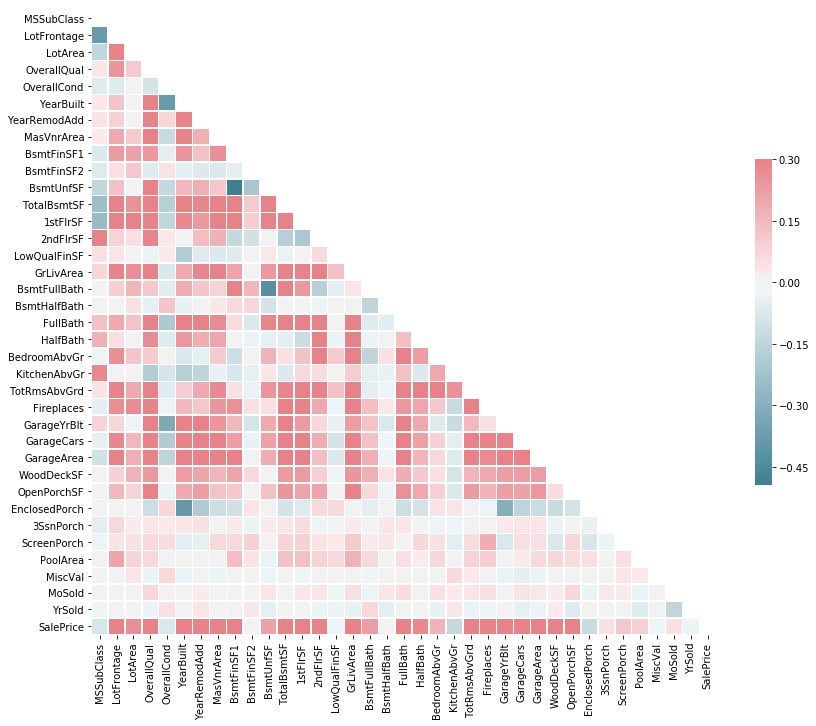
Top 50% Corralation train attributes with sale-price
top_feature = corr.index[abs(corr['SalePrice']>0.5)]
plt.subplots(figsize=(12, 8))
top_corr = df[top_feature].corr()
sns.heatmap(top_corr, annot=True)
plt.show()

OverallQual is highly correlated with target feature of saleprice by near 80%
sns.barplot(df.OverallQual, df.SalePrice)
<matplotlib.axes._subplots.AxesSubplot at 0x7fbbf16a0550>
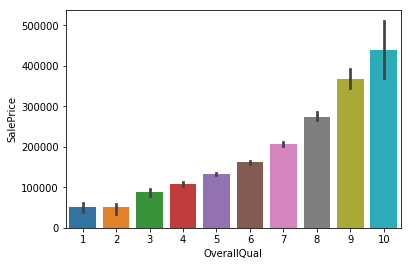
plt.figure(figsize=(18, 8))
sns.boxplot(x=df.OverallQual, y=df.SalePrice)
<matplotlib.axes._subplots.AxesSubplot at 0x7fbbf1335a20>
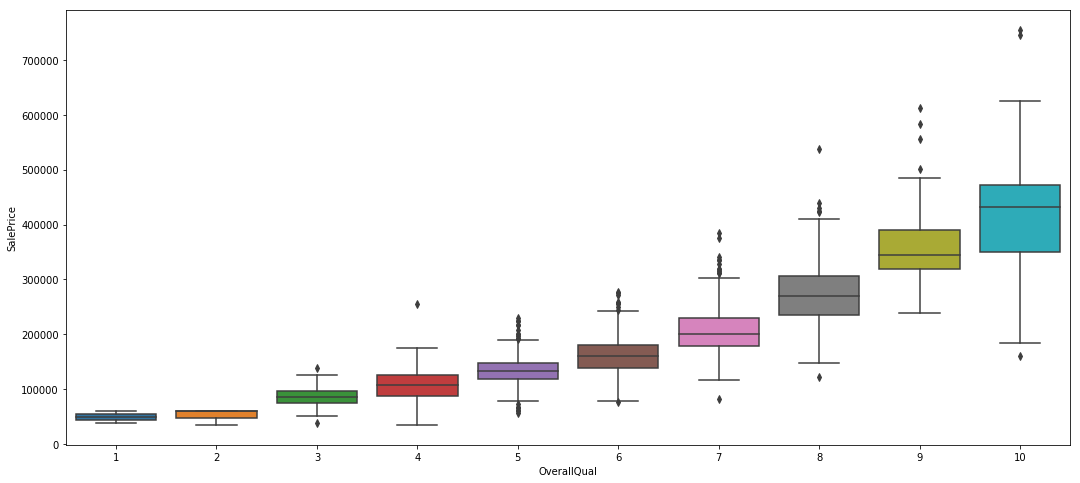
col = ['SalePrice', 'OverallQual', 'GrLivArea', 'GarageCars', 'TotalBsmtSF', 'FullBath', 'TotRmsAbvGrd', 'YearBuilt']
sns.pairplot(df[col], height=3, kind='reg')
<seaborn.axisgrid.PairGrid at 0x7fbbf1668898>
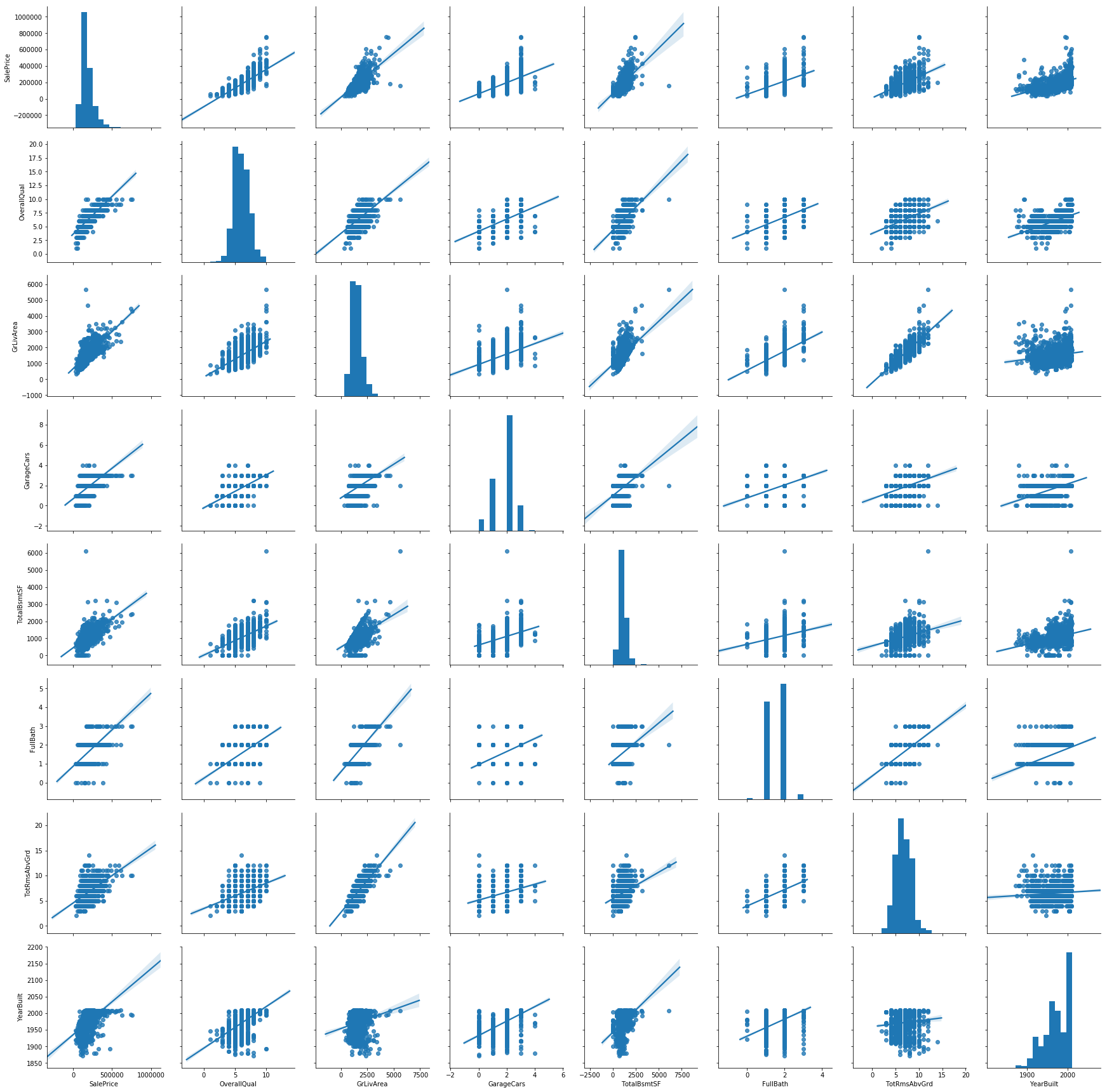
print("Most postively correlated features with the target")
corr = df.corr()
corr.sort_values(['SalePrice'], ascending=False, inplace=True)
corr.SalePrice
Most postively correlated features with the target
SalePrice 1.000000
OverallQual 0.790982
GrLivArea 0.708624
GarageCars 0.640409
GarageArea 0.623431
TotalBsmtSF 0.613581
1stFlrSF 0.605852
FullBath 0.560664
TotRmsAbvGrd 0.533723
YearBuilt 0.522897
YearRemodAdd 0.507101
GarageYrBlt 0.486362
MasVnrArea 0.477493
Fireplaces 0.466929
BsmtFinSF1 0.386420
LotFrontage 0.351799
WoodDeckSF 0.324413
2ndFlrSF 0.319334
OpenPorchSF 0.315856
HalfBath 0.284108
LotArea 0.263843
BsmtFullBath 0.227122
BsmtUnfSF 0.214479
BedroomAbvGr 0.168213
ScreenPorch 0.111447
PoolArea 0.092404
MoSold 0.046432
3SsnPorch 0.044584
BsmtFinSF2 -0.011378
BsmtHalfBath -0.016844
MiscVal -0.021190
LowQualFinSF -0.025606
YrSold -0.028923
OverallCond -0.077856
MSSubClass -0.084284
EnclosedPorch -0.128578
KitchenAbvGr -0.135907
Name: SalePrice, dtype: float64
Data preparation & feature engineering
Dealing with abnormal values
Not relevant here, we can assume that all values are been well integrated.
Data cleaning & Label encoding of categorical features
No duplicated rows
df.duplicated().sum()
0
Let’s remove columns with a high ratio of missing values
We don’t have much samples, so instead of removing rows with nan, missing values are then replaced by the median
from sklearn.preprocessing import LabelEncoder
def prepare_data(dataframe):
dataframe = dataframe.drop(columns=['PoolQC', 'MiscFeature', 'Alley', 'Fence', 'FireplaceQu'])
cat_feat = list(dataframe.select_dtypes('object').columns)
num_feat = list(dataframe.select_dtypes(exclude='object').columns)
dataframe[num_feat] = dataframe[num_feat].fillna(dataframe[num_feat].median())
dataframe[cat_feat] = dataframe[cat_feat].fillna("Not communicated")
for c in cat_feat:
lbl = LabelEncoder()
lbl.fit(list(dataframe[c].values))
dataframe[c] = lbl.transform(list(dataframe[c].values))
return dataframe
At first sight, there isn’t any value in the wrong type / format
Those features can’t be used as they are (in string format), this is why we need to convert them in a numerical way…
df = prepare_data(df)
Creation of new features
- In this case, it’s complicated to add features from an other dataset because no information is provided with the CSV file we’re using.
- All columns except the id (used as index) seems to be relevant, so all of them are kept at first.
- We can also combine features to create new ones - but in this case it doesn’t seem to be really usefull.
Standardization / normalization
Not needed here
#df[num_feat] = MinMaxScaler().fit_transform(df[num_feat])
Feature selection & and data preparation for models
y = df['SalePrice']
X = df.drop(columns=['SalePrice'])
X.shape, y.shape
((1460, 74), (1460,))
Let’s split the data into a train and a test set
X_train, X_test, y_train, y_test = train_test_split(X, y, test_size=0.2)
X_train.shape, X_test.shape, y_train.shape, y_test.shape
((1168, 74), (292, 74), (1168,), (292,))
Feature importance
Top 10 most important features:
rnd_reg = RandomForestRegressor(n_estimators=500, n_jobs=-1)
rnd_reg.fit(X, y)
feature_importances = pd.DataFrame(rnd_reg.feature_importances_, index = X.columns,
columns=['importance']).sort_values('importance', ascending=False)
feature_importances[:10]
| importance | |
|---|---|
| OverallQual | 0.578202 |
| GrLivArea | 0.109874 |
| TotalBsmtSF | 0.039231 |
| 2ndFlrSF | 0.035708 |
| BsmtFinSF1 | 0.029386 |
| 1stFlrSF | 0.022536 |
| GarageCars | 0.020744 |
| GarageArea | 0.015562 |
| LotArea | 0.013600 |
| YearBuilt | 0.009355 |
Graph with features sorted by importance
plt.figure(figsize=(10, 14))
sns.barplot(x="importance", y=feature_importances.index, data=feature_importances)
plt.show()
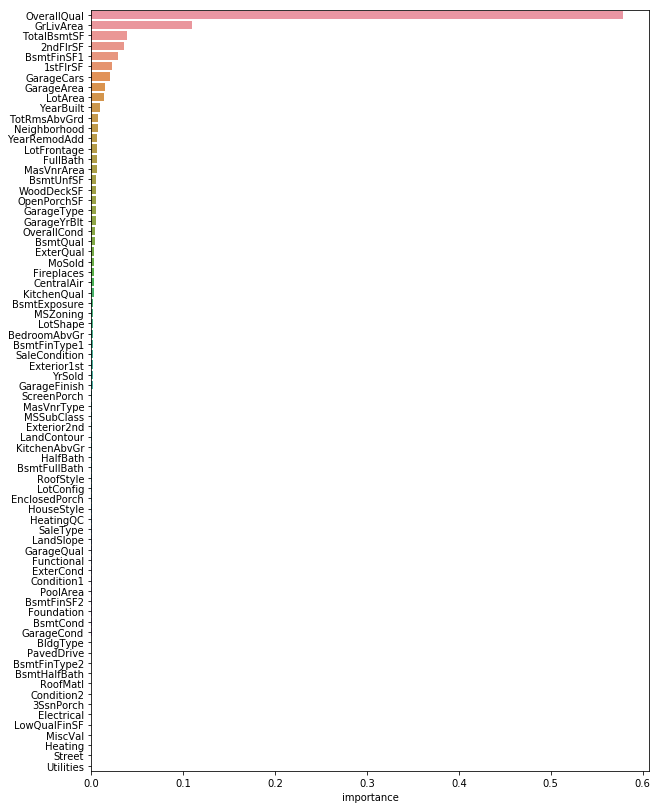
Training models and results
Baselines - first selection of models
# f1_score binary by default
def get_rmse(reg, model_name):
"""Print the score for the model passed in argument and retrun scores for the train/test sets"""
y_train_pred, y_pred = reg.predict(X_train), reg.predict(X_test)
rmse_train, rmse_test = np.sqrt(mean_squared_error(y_train, y_train_pred)), np.sqrt(mean_squared_error(y_test, y_pred))
print(model_name, f'\t - RMSE on Training = {rmse_train:.0f} / RMSE on Test = {rmse_test:.0f}')
return rmse_train, rmse_test
model_list = [
LinearRegression(), Lasso(), SVR(),
RandomForestRegressor(), GradientBoostingRegressor(), Ridge(), ElasticNet(), LinearSVC(),
BayesianRidge(), ExtraTreesRegressor()
]
model_names = [str(m)[:str(m).index('(')] for m in model_list]
rmse_train, rmse_test = [], []
model_names
['LinearRegression',
'Lasso',
'SVR',
'RandomForestRegressor',
'GradientBoostingRegressor',
'Ridge',
'ElasticNet',
'LinearSVC',
'BayesianRidge',
'ExtraTreesRegressor']
for model, name in zip(model_list, model_names):
model.fit(X_train, y_train)
sc_train, sc_test = get_rmse(model, name)
rmse_train.append(sc_train)
rmse_test.append(sc_test)
LinearRegression - RMSE on Training = 31163 / RMSE on Test = 32162
Lasso - RMSE on Training = 31163 / RMSE on Test = 32158
SVR - RMSE on Training = 79338 / RMSE on Test = 90251
RandomForestRegressor - RMSE on Training = 14748 / RMSE on Test = 30100
GradientBoostingRegressor - RMSE on Training = 13689 / RMSE on Test = 26783
Ridge - RMSE on Training = 31176 / RMSE on Test = 32091
ElasticNet - RMSE on Training = 32547 / RMSE on Test = 33122
LinearSVC - RMSE on Training = 94350 / RMSE on Test = 105986
BayesianRidge - RMSE on Training = 31599 / RMSE on Test = 31864
ExtraTreesRegressor - RMSE on Training = 0 / RMSE on Test = 30023
Results comparison chart
df_score = pd.DataFrame({'model_names' : model_names,
'rmse_train' : rmse_train,
'rmse_test' : rmse_test})
ax = df_score.plot.barh(y=['rmse_test', 'rmse_train'], x='model_names')
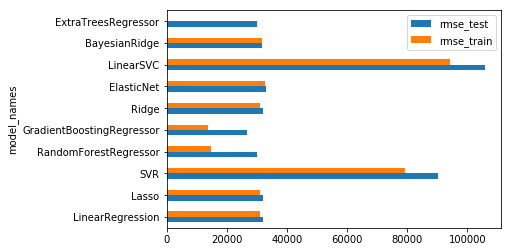
The LinearSVC model isn’t performing well because data haven’t been scaled before, let’s do it with a pipeline:
svm_reg = Pipeline([
("scaler", StandardScaler()),
("svm_regresssor", LinearSVC())
])
svm_reg.fit(X_train, y_train)
_, _ = get_rmse(svm_reg, "svr_rbf")
svr_rbf - RMSE on Training = 2158 / RMSE on Test = 70136
That’s much better, although it seems the linear kernel is the best option here:
svr_rbf = SVR(kernel = 'rbf')
svr_rbf.fit(X_train, y_train)
_, _ = get_rmse(svr_rbf, "svr_rbf")
svr_rbf - RMSE on Training = 79338 / RMSE on Test = 90251
svm_reg = Pipeline([
("scaler", StandardScaler()),
("svm_regresssor", SVR())
])
svm_reg.fit(X_train, y_train)
_, _ = get_rmse(svm_reg, "svr_rbf")
svm_reg = Pipeline([
("scaler", StandardScaler()),
("svm_regresssor", SVR(kernel="poly"))
])
svm_reg.fit(X_train, y_train)
_, _ = get_rmse(svm_reg, "svr_poly")
sgd_reg = Pipeline([
("scaler", StandardScaler()),
("sgd_regresssor", SGDRegressor())
])
sgd_reg.fit(X_train, y_train)
_, _ = get_rmse(sgd_reg, "sgd_reg")
svr_rbf - RMSE on Training = 79310 / RMSE on Test = 90222
svr_poly - RMSE on Training = 79315 / RMSE on Test = 90224
sgd_reg - RMSE on Training = 31546 / RMSE on Test = 34055
The same remark comes true also for the SGD Regressor model
Let’s try XGBoost !
xgb_reg = xgb.XGBRegressor()
xgb_reg.fit(X_train, y_train)
_, _ = get_rmse(xgb_reg, "xgb_reg")
xgb_reg - RMSE on Training = 14601 / RMSE on Test = 27209
Looks promissing, here we can conclude that RandomForestRegressor, GradientBoostingRegressor and XGBoost seems to be the models we’ll keep for hyperparameters tuning !
Model optimisation
RandomForrestReg
from sklearn.model_selection import GridSearchCV
rf = RandomForestRegressor()
param_grid = {
'n_estimators': [80, 100, 120],
'max_features': [14, 15, 16, 17],
'max_depth' : [14, 16, 18]
}
rfc_cv = GridSearchCV(estimator=rf, param_grid=param_grid, cv=5, n_jobs=-1)
rfc_cv.fit(X_train, y_train)
print(rfc_cv.best_params_)
_, _ = get_rmse(rfc_cv, "rfc_reg")
{'max_depth': 18, 'max_features': 17, 'n_estimators': 100}
rfc_reg - RMSE on Training = 11404 / RMSE on Test = 29079
GradientBoostingReg
gb = GradientBoostingRegressor()
param_grid = {
'n_estimators': [100, 400],
'max_features': [14, 15, 16, 17],
'max_depth' : [1, 2, 8, 14, 18]
}
gb_cv = GridSearchCV(estimator=gb, param_grid=param_grid, cv=5, n_jobs=-1)
gb_cv.fit(X_train, y_train)
print(gb_cv.best_params_)
_, _ = get_rmse(gb_cv, "gb_cv")
{'max_depth': 8, 'max_features': 15, 'n_estimators': 100}
gb_cv - RMSE on Training = 1180 / RMSE on Test = 25624
XGBoostReg
xg = xgb.XGBRegressor()
param_grid = {
'n_estimators': [100, 400],
'max_features': [10, 14, 16],
'max_depth' : [1, 2, 8, 18]
}
xg_cv = GridSearchCV(estimator=xg, param_grid=param_grid, cv=5, n_jobs=-1)
xg_cv.fit(X_train, y_train)
print(xg_cv.best_params_)
_, _ = get_rmse(xg_cv, "xg_cv")
{'max_depth': 8, 'max_features': 10, 'n_estimators': 100}
xg_cv - RMSE on Training = 2478 / RMSE on Test = 28332
Combination of the best models & submission
df_test = pd.read_csv('../input/test.csv', index_col='Id' )
df_test.head()
| MSSubClass | MSZoning | LotFrontage | LotArea | Street | Alley | LotShape | LandContour | Utilities | LotConfig | LandSlope | Neighborhood | Condition1 | Condition2 | BldgType | HouseStyle | OverallQual | OverallCond | YearBuilt | YearRemodAdd | RoofStyle | RoofMatl | Exterior1st | Exterior2nd | MasVnrType | MasVnrArea | ExterQual | ExterCond | Foundation | BsmtQual | BsmtCond | BsmtExposure | BsmtFinType1 | BsmtFinSF1 | BsmtFinType2 | BsmtFinSF2 | BsmtUnfSF | TotalBsmtSF | Heating | HeatingQC | CentralAir | Electrical | 1stFlrSF | 2ndFlrSF | LowQualFinSF | GrLivArea | BsmtFullBath | BsmtHalfBath | FullBath | HalfBath | BedroomAbvGr | KitchenAbvGr | KitchenQual | TotRmsAbvGrd | Functional | Fireplaces | FireplaceQu | GarageType | GarageYrBlt | GarageFinish | GarageCars | GarageArea | GarageQual | GarageCond | PavedDrive | WoodDeckSF | OpenPorchSF | EnclosedPorch | 3SsnPorch | ScreenPorch | PoolArea | PoolQC | Fence | MiscFeature | MiscVal | MoSold | YrSold | SaleType | SaleCondition | |
|---|---|---|---|---|---|---|---|---|---|---|---|---|---|---|---|---|---|---|---|---|---|---|---|---|---|---|---|---|---|---|---|---|---|---|---|---|---|---|---|---|---|---|---|---|---|---|---|---|---|---|---|---|---|---|---|---|---|---|---|---|---|---|---|---|---|---|---|---|---|---|---|---|---|---|---|---|---|---|---|
| Id | |||||||||||||||||||||||||||||||||||||||||||||||||||||||||||||||||||||||||||||||
| 1461 | 20 | RH | 80.0 | 11622 | Pave | NaN | Reg | Lvl | AllPub | Inside | Gtl | NAmes | Feedr | Norm | 1Fam | 1Story | 5 | 6 | 1961 | 1961 | Gable | CompShg | VinylSd | VinylSd | None | 0.0 | TA | TA | CBlock | TA | TA | No | Rec | 468.0 | LwQ | 144.0 | 270.0 | 882.0 | GasA | TA | Y | SBrkr | 896 | 0 | 0 | 896 | 0.0 | 0.0 | 1 | 0 | 2 | 1 | TA | 5 | Typ | 0 | NaN | Attchd | 1961.0 | Unf | 1.0 | 730.0 | TA | TA | Y | 140 | 0 | 0 | 0 | 120 | 0 | NaN | MnPrv | NaN | 0 | 6 | 2010 | WD | Normal |
| 1462 | 20 | RL | 81.0 | 14267 | Pave | NaN | IR1 | Lvl | AllPub | Corner | Gtl | NAmes | Norm | Norm | 1Fam | 1Story | 6 | 6 | 1958 | 1958 | Hip | CompShg | Wd Sdng | Wd Sdng | BrkFace | 108.0 | TA | TA | CBlock | TA | TA | No | ALQ | 923.0 | Unf | 0.0 | 406.0 | 1329.0 | GasA | TA | Y | SBrkr | 1329 | 0 | 0 | 1329 | 0.0 | 0.0 | 1 | 1 | 3 | 1 | Gd | 6 | Typ | 0 | NaN | Attchd | 1958.0 | Unf | 1.0 | 312.0 | TA | TA | Y | 393 | 36 | 0 | 0 | 0 | 0 | NaN | NaN | Gar2 | 12500 | 6 | 2010 | WD | Normal |
| 1463 | 60 | RL | 74.0 | 13830 | Pave | NaN | IR1 | Lvl | AllPub | Inside | Gtl | Gilbert | Norm | Norm | 1Fam | 2Story | 5 | 5 | 1997 | 1998 | Gable | CompShg | VinylSd | VinylSd | None | 0.0 | TA | TA | PConc | Gd | TA | No | GLQ | 791.0 | Unf | 0.0 | 137.0 | 928.0 | GasA | Gd | Y | SBrkr | 928 | 701 | 0 | 1629 | 0.0 | 0.0 | 2 | 1 | 3 | 1 | TA | 6 | Typ | 1 | TA | Attchd | 1997.0 | Fin | 2.0 | 482.0 | TA | TA | Y | 212 | 34 | 0 | 0 | 0 | 0 | NaN | MnPrv | NaN | 0 | 3 | 2010 | WD | Normal |
| 1464 | 60 | RL | 78.0 | 9978 | Pave | NaN | IR1 | Lvl | AllPub | Inside | Gtl | Gilbert | Norm | Norm | 1Fam | 2Story | 6 | 6 | 1998 | 1998 | Gable | CompShg | VinylSd | VinylSd | BrkFace | 20.0 | TA | TA | PConc | TA | TA | No | GLQ | 602.0 | Unf | 0.0 | 324.0 | 926.0 | GasA | Ex | Y | SBrkr | 926 | 678 | 0 | 1604 | 0.0 | 0.0 | 2 | 1 | 3 | 1 | Gd | 7 | Typ | 1 | Gd | Attchd | 1998.0 | Fin | 2.0 | 470.0 | TA | TA | Y | 360 | 36 | 0 | 0 | 0 | 0 | NaN | NaN | NaN | 0 | 6 | 2010 | WD | Normal |
| 1465 | 120 | RL | 43.0 | 5005 | Pave | NaN | IR1 | HLS | AllPub | Inside | Gtl | StoneBr | Norm | Norm | TwnhsE | 1Story | 8 | 5 | 1992 | 1992 | Gable | CompShg | HdBoard | HdBoard | None | 0.0 | Gd | TA | PConc | Gd | TA | No | ALQ | 263.0 | Unf | 0.0 | 1017.0 | 1280.0 | GasA | Ex | Y | SBrkr | 1280 | 0 | 0 | 1280 | 0.0 | 0.0 | 2 | 0 | 2 | 1 | Gd | 5 | Typ | 0 | NaN | Attchd | 1992.0 | RFn | 2.0 | 506.0 | TA | TA | Y | 0 | 82 | 0 | 0 | 144 | 0 | NaN | NaN | NaN | 0 | 1 | 2010 | WD | Normal |
df_test = prepare_data(df_test)
df_test.shape
(1459, 74)
rfc_sub, gb_sub, xg_sub = rfc_cv.predict(df_test), gb_cv.predict(df_test), xg_cv.predict(df_test)
sub = pd.DataFrame()
sub['Id'] = df_test.index
sub['SalePrice'] = np.mean([rfc_sub, gb_sub, xg_sub], axis=0) / 3
sub.to_csv('submission.csv',index=False)
If you found this notebook helpful or you just liked it , some upvotes would be very much appreciated - That will keep me motivated to update it on a regular basis :-)


